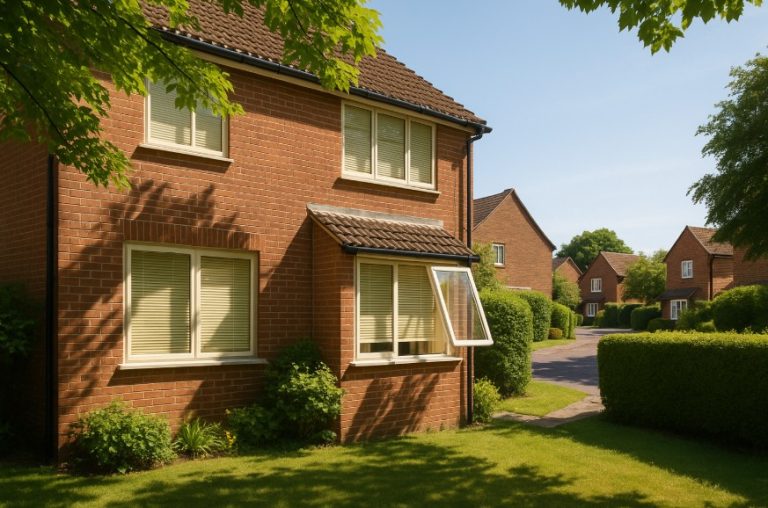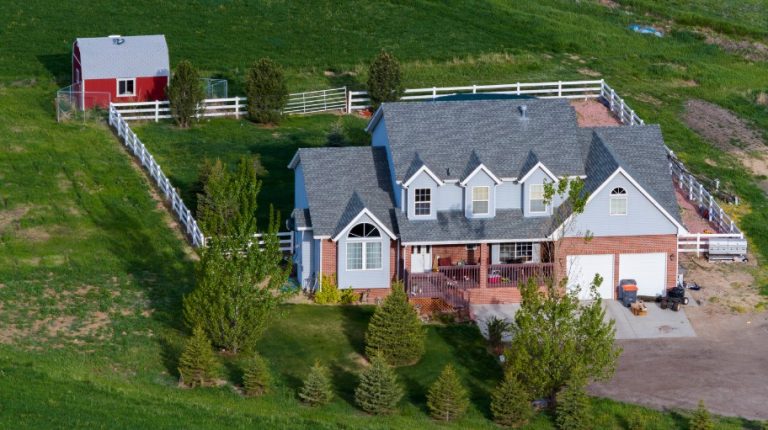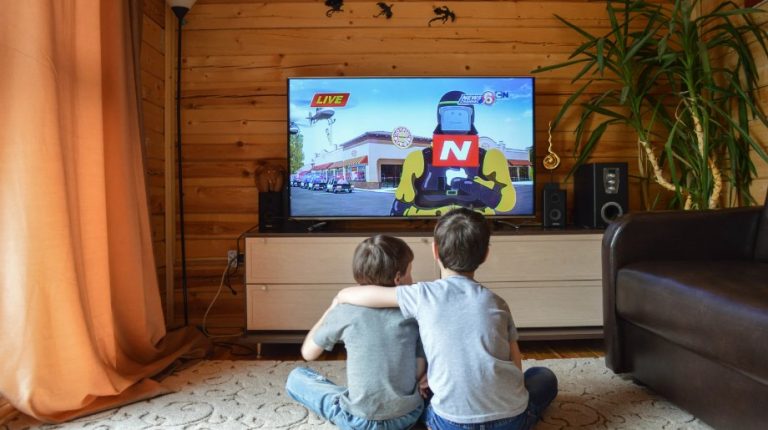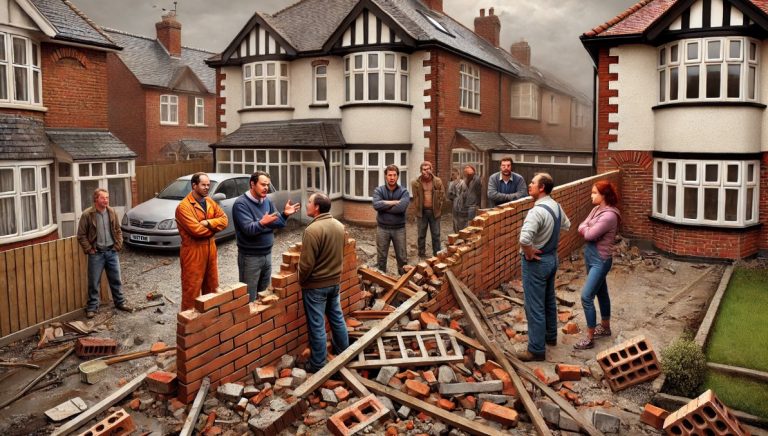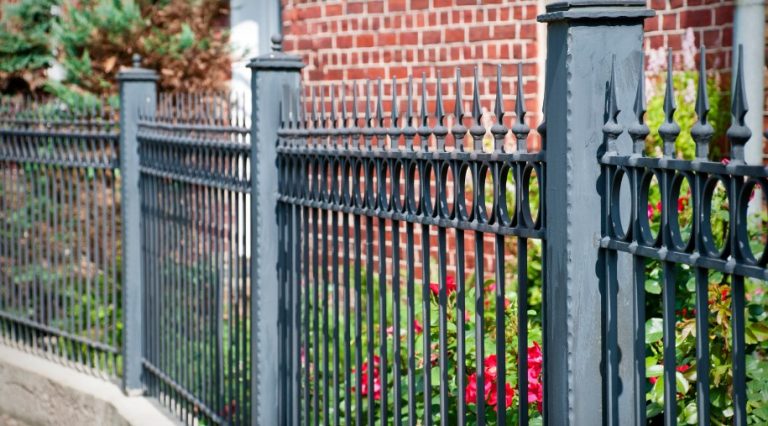Turfing a lawn is a popular way to enhance the visual appeal and usability of outdoor spaces in the UK. Whether it’s a residential garden or a commercial landscape, choosing between real grass and artificial turf can significantly impact both the initial investment and long-term maintenance costs.
This guide aims to break down how much turf costs per square metre, helping homeowners and property developers make an informed decision.
What Is the Average Cost of Turf Per Square Metre in the UK?
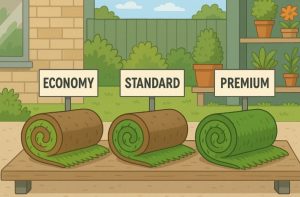
The cost of turf per square metre can vary widely in the UK depending on the type and quality of the turf being purchased. Suppliers typically offer both real grass and artificial turf options, each with its own pricing structure.
Price Range for Real Grass Turf
Real grass turf remains a popular choice for traditional garden spaces. It is generally priced lower than synthetic options, making it a budget-friendly solution for homeowners.
- Economy turf is the most affordable, often used for temporary or less visible garden areas. Prices start at around £2.50 per square metre.
- Standard grade turf is designed for domestic use and typically costs between £4.00 and £6.00 per square metre.
- Premium turf, such as ornamental or shade-tolerant blends, may cost anywhere from £6.50 to £10.00 per square metre depending on the supplier and seed composition.
Prices do not usually include the cost of delivery or installation, both of which can significantly affect the total.
Price Range for Artificial Turf
Artificial turf is more expensive upfront but is chosen for its durability, minimal upkeep, and year-round green appearance.
- Entry-level artificial grass is available at prices starting around £10.00 per square metre.
- Mid-range options that include a thicker pile and more natural appearance are priced between £16.00 and £25.00 per square metre.
- High-end artificial grass, often UV resistant and featuring multi-tone colouring for realism, can range from £26.00 to £35.00 per square metre.
In many cases, artificial turf includes a secondary backing for added resilience, which contributes to its cost.
What Factors Affect the Cost of Turfing a Lawn?
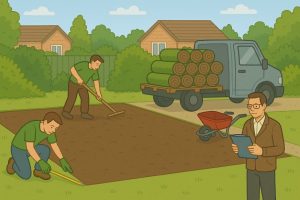
Several variables influence the final cost of a turfing project. Understanding these factors can help homeowners plan their budget more effectively.
Type of Turf
Real grass turf is generally more affordable to purchase but requires ongoing maintenance including mowing, watering, and fertilisation. Artificial turf has a higher upfront cost but typically pays for itself over time due to lower maintenance expenses.
Size of the Area
The overall size of the lawn significantly affects cost. Larger gardens may benefit from bulk discounts, but they also require more materials and time for installation. Smaller gardens may have higher per-square-metre costs due to delivery minimums and smaller roll sizes.
Installation and Labour
Labour costs depend on the complexity of the job. Ground preparation, soil levelling, and removal of existing grass can raise costs considerably.
- Professional installation for real grass ranges from £10 to £15 per square metre.
- Artificial turf installation may cost £15 to £25 per square metre due to the need for a base layer and more detailed fitting.
Delivery Charges
Delivery charges depend on order size and supplier location. For smaller quantities, costs may be higher due to minimum order requirements. Some suppliers offer free delivery for bulk orders within a certain radius.
Turf Quality
Premium turfs come with added features such as better drought resistance, improved rooting systems, or enhanced aesthetic properties. Higher turf quality usually leads to better long-term performance but increases the initial cost.
How Does Real Grass Compare to Artificial Grass?
Real and artificial turf each offer distinct benefits. The best choice depends on intended use, aesthetics, and budget.
Appearance and Maintenance
- Real grass delivers a natural feel and smell but requires regular maintenance.
- Artificial grass remains consistently green and needs very little upkeep.
Artificial turf has become more realistic in recent years, with newer products mimicking the look and feel of natural lawns through multi-tonal fibres and thatch layers.
Environmental Considerations
Real grass helps absorb carbon dioxide and contributes to a healthy ecosystem by supporting insects and soil organisms. Artificial grass, made from plastic, does not offer the same environmental benefits but reduces water usage and eliminates the need for fertilisers or pesticides.
Long-Term Financial Comparison
Below is a comparative table based on a 10-year period for a 50 square metre garden:
| Feature | Real Grass Turf | Artificial Turf |
| Initial Turf Cost | £250 – £500 | £800 – £1,400 |
| Installation (Professional) | £500 – £750 | £1,000 – £1,250 |
| Annual Maintenance | £100 – £250 | £10 – £30 |
| Total 10-Year Cost Estimate | £1,750 – £4,000 | £1,900 – £2,950 |
| Lifespan | 5 to 10 years | 10 to 20 years |
While real grass is cheaper at the start, its upkeep makes it more expensive over time compared to synthetic turf.
What Are the Costs of Turf Installation in the UK?
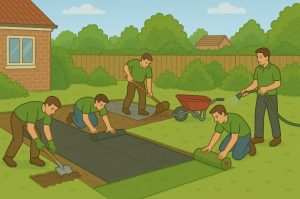
The installation process is a key part of the overall cost, especially when switching from a poorly maintained or paved surface to a freshly turfed garden.
DIY vs Professional Installation
Homeowners can lay real turf themselves with minimal tools, although poor installation can result in uneven growth or weed intrusion. Artificial turf, on the other hand, requires careful surface preparation and the use of specialist materials.
A professional installation includes:
- Clearing the area
- Laying a weed membrane
- Installing a sub-base (usually MOT Type 1 or granite dust for artificial turf)
- Compaction and levelling
- Laying and securing the turf
- Adding infill for artificial options
Sample Cost Breakdown for a 50m² Lawn
| Cost Component | Real Grass Turf | Artificial Turf |
| Turf Rolls (50m²) | £250 – £500 | £800 – £1,400 |
| Ground Preparation & Labour | £500 – £750 | £1,000 – £1,250 |
| Additional Materials (membrane, fixings) | £50 – £100 | £150 – £300 |
| Estimated Total Installation | £800 – £1,350 | £1,950 – £2,950 |
These figures may vary depending on geographic location and individual supplier rates.
Where Can You Buy Turf Online or Locally in the UK?
There is a wide range of turf suppliers available throughout the UK, offering both delivery and collection options. Larger chains often carry basic ranges, while specialists provide premium turf blends.
Top UK Turf Suppliers
- Rolawn: Known for premium turf and fast delivery options
- TurfOnline: Offers a wide variety of real and artificial turf types
- The Grass People: Specialise in seed mixes and budget turfing options
- Lawnsmith: Provides professional-grade turf and aftercare advice
- B&Q and Wickes: Good for DIY projects with lower volume requirements
Delivery Options and Timeframes
- Standard delivery times: 2 to 5 working days
- Same-day delivery is sometimes available for orders placed early in the day
- Delivery costs range from £20 to £50 depending on location and order size
Some companies offer weekend delivery or time-slot selections at an extra fee. Bulk orders may qualify for free delivery or volume discounts.
Is Artificial Turf Worth the Investment?
Artificial turf may cost more initially, but its convenience and longevity often outweigh the initial expenditure. For properties that see heavy foot traffic or lack consistent sunlight, synthetic grass can maintain a pristine look without ongoing care.
Cost vs Lifespan
The average lifespan of artificial turf is between 10 and 20 years depending on the quality and level of use. Real grass, while natural, may require reseeding or replacement every few years if poorly maintained.
Potential Applications
- Family homes with children or pets
- Rental properties where low-maintenance gardens are preferred
- Schools, nurseries, and public play areas
- Shaded areas where real grass struggles to grow
Artificial turf is also used on balconies and roof terraces where installing real grass isn’t feasible.
How Can You Save Money on Turfing Your Garden?
Although turfing can be a significant investment, several strategies can help reduce costs.
- Buy during off-peak seasons such as early spring or autumn when prices are lower
- Take advantage of promotions or discounts from online suppliers
- Do part of the work yourself, such as clearing the garden or laying a membrane
- Choose budget-grade turf for less visible or smaller areas
- Team up with neighbours for bulk orders and split delivery costs
Some suppliers also offer pre-cut roll sizes, allowing more precise coverage and minimising waste.
Is Investing in Turf a Good Idea Now?
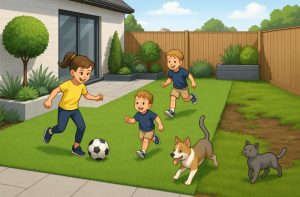
Turf installation, whether natural or artificial, is increasingly being seen as a worthwhile investment by UK homeowners and property developers. With evolving lifestyle needs and a growing emphasis on outdoor living spaces, the decision to invest in turf in 2025 is more relevant than ever.
Market Trends in Turf Usage
Over the past few years, demand for low-maintenance, attractive gardens has grown across both residential and commercial sectors. With the shift toward remote working and spending more time at home, homeowners are placing greater value on functional and visually appealing outdoor spaces. Turf offers a simple solution to transforming dull or underutilised garden areas into vibrant, usable lawns.
Real grass remains a favourite for traditionalists who appreciate the natural look and environmental benefits. Meanwhile, artificial turf is seeing rising popularity due to its durability and minimal maintenance requirements.
Why Turfing Makes Sense in 2025?
There are several reasons why now is a good time to invest in turf:
- Property value enhancement: A well-maintained lawn can improve a property’s kerb appeal, potentially raising resale value or rental desirability.
- Increased usability: Turf allows gardens to be used year-round, especially when artificial turf is used in high-traffic areas or spaces prone to waterlogging.
- Environmental incentives: Choosing eco-friendly real grass options, such as drought-tolerant or native species, supports biodiversity and reduces water use.
Return on Investment
While turf installation has an upfront cost, the long-term return can be seen through reduced garden maintenance, increased enjoyment of outdoor areas, and better marketability of the property. Artificial turf, in particular, can pay for itself over 8–10 years when compared to the cost of maintaining a traditional lawn.
When It May Not Be Ideal?
However, turfing may not be the best investment for every situation:
- Properties with large shaded areas may struggle to grow real grass unless specialist varieties are chosen.
- Artificial turf might not be suitable for environmentally conscious homeowners concerned about plastic use.
- In rental properties with short tenancy turnover, the cost of artificial turf may not be justified unless damage to real grass is a recurring issue.
Conclusion
Choosing between real grass and artificial turf depends on budget, lifestyle, and long-term goals. While real turf offers natural beauty at a lower initial cost, artificial turf is a smart investment for those seeking a low-maintenance, year-round green lawn. By comparing prices, installation costs, and upkeep, homeowners can make the most cost-effective choice for their garden.
FAQs About Turf Pricing and Installation
What is the cheapest turf option available in the UK?
The cheapest turf is basic real grass turf, priced around £2.50 per m², often available from local suppliers or wholesale landscapers.
How long does it take to install turf on a 50m² lawn?
Professional turfing usually takes 1–2 days for a 50m² lawn, depending on site prep and weather conditions.
Is it more expensive to maintain real grass or artificial turf?
Real grass has higher long-term maintenance costs, including watering, fertilising, and mowing. Artificial turf requires minimal upkeep.
Can artificial turf be laid on concrete or patio surfaces?
Yes, artificial turf can be laid on hard surfaces with suitable underlay and adhesive, making it ideal for balconies and patios.
Are there turf options for shaded areas?
Yes, some real grass turfs are specially blended for low-light conditions, often labelled as “shade-tolerant” turf.
Do I need planning permission to install artificial grass?
Generally, no planning permission is required for turf installation, but some councils restrict it in front gardens for environmental reasons.
What maintenance is required for artificial grass?
Regular brushing, occasional rinsing, and removal of debris are sufficient to keep artificial grass clean and tidy.


